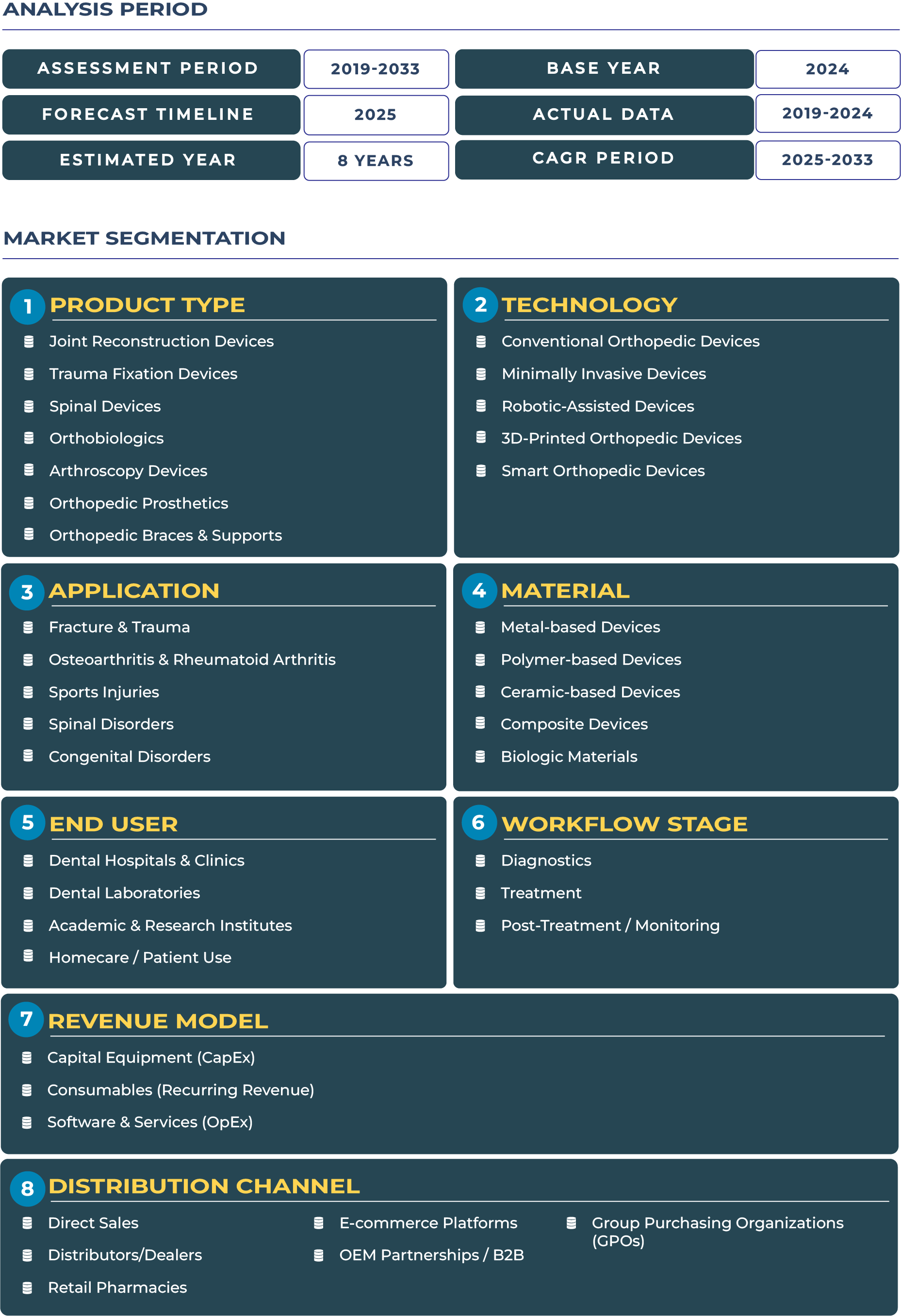Report Format:
![]()
![]() |
Pages: 110+
|
Pages: 110+
Russia Orthopedic Devices Market Outlook: National Healthcare Modernization Anchoring Russia Orthopedic Devices Growth
The Russia orthopedic devices market is forecast to steadily expand from USD 1.96 billion in 2025 to USD 2.46 billion by 2033. Growth is anchored in state-driven hospital procurement frameworks, which prioritize cost-efficient implants, trauma fixation solutions, and orthopedic prosthetics. While the pace of expansion is slower compared to some neighboring Eastern European countries, steady demand is supported by high volumes of road-traffic-related trauma cases and an aging population requiring joint replacement and spinal surgeries. Russia’s investment in advanced hospital infrastructure in metropolitan cities such as Moscow and St. Petersburg, along with regional hospital upgrades, is creating stable opportunities for device manufacturers. Despite economic sanctions and limited access to certain Western technologies, Russia Orthopedic Devices ecosystem continues to evolve through domestic production initiatives, public health projects, and collaborations with neutral international suppliers.
Russia Orthopedic Devices Market: National Health Projects Accelerating Orthopedic Innovation
Russia Orthopedic Devices market is being significantly shaped by the government’s large-scale health initiatives under national projects aimed at improving surgical care and hospital infrastructure. These projects emphasize the modernization of trauma and rehabilitation facilities, as well as centralized procurement of implants and devices, creating opportunities for manufacturers of joint reconstruction, trauma fixation, and spinal devices. By channeling state resources into healthcare, Russia is driving demand for orthopedic implants and expanding accessibility across both urban hospitals and regional care facilities. Public investment is particularly critical in an environment where sanctions and import restrictions complicate supply chains, making domestic innovation and manufacturing capacity central to sustaining growth in the orthopedic devices industry.
Drivers & Restraints: Evaluating the Strengths and Vulnerabilities of Russia Orthopedic Devices Industry
Large Urban Surgical Centers and Trauma Volumes Supporting Market Growth
One of the strongest drivers in Russia Orthopedic Devices sector is the concentration of large surgical centers in metropolitan areas. These centers handle significant volumes of orthopedic procedures, including trauma fixation and joint replacements. Rising accident-related injuries and lifestyle-driven orthopedic conditions are generating consistent demand for implants and prosthetics. Russia also possesses domestic manufacturing capacity for certain orthopedic devices, which reduces reliance on foreign imports and improves supply continuity. The presence of government-financed tenders for bulk procurement further ensures a steady base demand for orthopedic implants, particularly for trauma fixation systems and orthopedic prosthetics that are critical in public hospitals.
Sanctions, Import Restrictions, and Procurement Uncertainty Hindering Growth
On the restraint side, international sanctions have disrupted the import of advanced medical devices and high-quality surgical navigation systems into Russia. Import restrictions have forced hospitals to depend more on domestic suppliers, limiting the variety and sophistication of devices available to surgeons. Currency volatility adds another layer of complexity, making imported implants expensive and less accessible to regional hospitals. Furthermore, uncertainties in public procurement cycles sometimes delay timely delivery of critical devices, creating a mismatch between demand and availability. These restraints highlight the need for stronger domestic manufacturing capabilities and diversified supply partnerships to mitigate risks in the orthopedic devices landscape.
Trends & Opportunities: Navigating Shifts in Russia Orthopedic Devices Ecosystem
Shift to Domestic Suppliers and Regional Hospital Upgrades Driving Trends
A defining trend in the Russia orthopedic devices market is the accelerated shift toward domestic suppliers as hospitals adapt to sanctions-related restrictions. Local manufacturers are increasingly producing cost-competitive implants and orthopedic prosthetics, which are gaining acceptance through state-backed procurement programs. Regional hospitals are also undergoing upgrades as part of national health projects, creating demand for basic trauma fixation devices and entry-level arthroscopy solutions. These investments are bridging healthcare disparities between large urban hospitals and smaller regional centers, expanding patient access to orthopedic care across Russia.
Localization of Manufacturing and Tele-Training Creating New Opportunities
Opportunities in Russia Orthopedic Devices market are centered on the localization of manufacturing and the development of after-sales and spare parts services. Local joint ventures with international companies are helping to mitigate import risks and ensure supply continuity. Additionally, as many regional hospitals face shortages of highly skilled surgeons, tele-training programs are emerging as a practical solution to transfer knowledge and skills in spinal surgeries and arthroscopy procedures. Manufacturers that invest in surgeon education, remote training modules, and localized production facilities will find long-term advantages in navigating Russia’s evolving orthopedic devices sector.
Competitive Landscape: Local Joint Ventures and Stocked Inventories Defining Competitive Strategies
The competitive landscape in Russia Orthopedic Devices market reflects a mix of domestic companies and global leaders adapting to the sanctions-driven environment. Companies such as Smith+Nephew maintain a presence through strategic partnerships, while local Russian manufacturers focus on cost-efficient implant lines tailored for government tenders. A notable trend is the establishment of local manufacturing joint ventures, which help international companies mitigate sanctions risk and secure regulatory approval faster. Stocking local inventories has also become essential to ensure continuity in supply chains, given currency risks and logistical delays. Furthermore, companies are investing in training programs for provincial surgeons, enabling better utilization of available devices and reducing the urban-rural care gap. These strategies collectively strengthen competitiveness and resilience in Russia Orthopedic Devices industry despite challenging external conditions.







